 |
|||||
|
|
|||||
|
NTT around the World Vol. 8, No. 6, pp. 29–33, June 2010. https://doi.org/10.53829/ntr201006ov1  NTT Europe Online—
|
|||||
| † | NTT Europe Online St. Katharine’s Way, London E1W 1LB, UK |
|---|
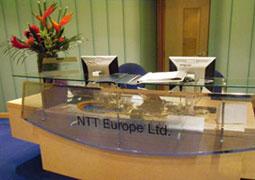
The entrance of NTT Europe

Devon House, the office’s location
1. Introduction
NTT Europe was established in London as a branch of NTT in 1989 and is currently a subsidiary of NTT Communications. It has mainly been providing high-quality network services to customers in Europe. On the other hand, NTT Europe Online [1], which currently has a rather similar name, used to be Verio Europe, part of Verio, which became part of NTT Communications through merger and acquisition in 2000. It specialises in hosting services and is now working with NTT Europe to provide high-quality one-stop services with integrated network and hosting services. Both companies have many branches to cover the Europe, Middle East, & Africa region (EMEA), especially in the UK, France, Germany, Spain, and the Netherlands, and they recently opened a Brussels branch in Belgium (Fig. 1). They also collaborate with NTT Communications Russia in Moscow and St. Petersburg and NTT Communications representative offices in Warsaw and Dubai. These companies are providing various information and communications technology (ICT) solutions to accelerate customers’ business and are striving to maintain a high level of service quality.
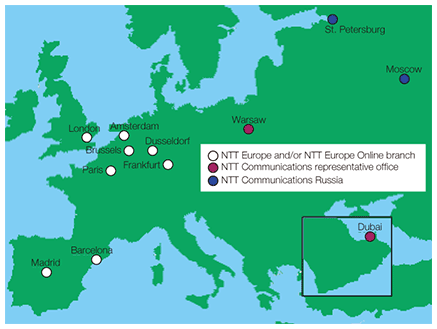
Fig. 1. NTT Europe branches.
I am a systems engineer for NTT Europe Online just coming to the end of a one-year assignment from April 2009 to March 2010. My work involves engineering and deploying our content delivery network platforms called Smart Content Delivery, which is for hypertext transfer protocol (HTTP) content delivery such as web contents, and Smart Media Delivery, which is for audio and video media streaming delivery. Europe produces a variety of contents and services of interest to people all over the world. These platforms enable the delivery of such contents and services via the Internet.
2. ICT solutions
NTT Europe and NTT Europe Online have various high-quality ICT solutions, especially ones endorsed by the connection to Global Tier 1 Internet protocol (IP) backbone networks.
2.1 Global network services
Global network services include a data network and IP transit services and a service for monitoring them. Our data network service provides a virtual private network (VPN) and leased lines customised to a customer’s network and business. For example, the Arcstar Global IP-VPN Service provides end-to-end service covering ordering, installation, management, and maintenance for the customer’s network by using multiprotocol label switching technology on a shared platform with a high level of security. The IP transit service provides a high-speed high-availability seamless service from a single worldwide network of autonomous systems by connecting to our Global Tier 1 IP backbone. Direct connection to major Internet service providers in many countries makes Internet access faster and minimises distance-based delays. We also provide IPv6 (IP version 6) network transit globally. In addition, their monitoring service allows customers to optimise their systems by monitoring traffic, application types, and IP address destinations.
2.2 Global managed IT services
Global managed information technology (IT) services include the IT system management, security management, and wide area network (WAN) performance management services. The IT system management service provides total support for IT assets and performance management, software updating, and 24/7 security and support for local area networks and servers. The security management service provides gateways, firewalls, quarantine, and unified threat management services to protect customers’ IT systems from threats on the Internet. The WAN performance management service improves application throughput between remote locations and accelerates network speed through the use of flow controls for applications and for transmission control protocol (TCP).
2.3 Data centre and managed hosting services
Data centre services provides stable and high-quality data centre facilities endorsed by the Tier 1 IP backbone. The colocation service offers optimised power supplies, air conditioning, and network connections for customers’ servers. The managed hosting service also offers the foundations for the reliability, availability, security, and scalability of customers’ online presence and critical business applications; it includes a comprehensive portal, monitoring services, backup services, security services, and operating system and application management. In addition, virtualisation services offer customers a superior level of self-service control of their virtualised systems and increase the flexibility and efficiency of customers’ service deployment processes. Customers can configure, provision, and manage their virtualised IT environments online via our customer portal site. A global virtualisation service, which provides virtualisation services in Asia, the USA, and Europe, has also been launched. It enables customers to expand their footprint easily and rapidly.
3. Content delivery network platforms
A content delivery network (CDN) platform (Fig. 2) is a network platform for efficiently delivering contents such as web contents, audio, and video. For efficient content delivery, two factors are important: high performance and high availability. High performance means high-speed delivery to end users by providing contents to them from the nearest servers and using high-speed networks, having enough capacity to serve contents to millions of end users, and minimising the load on the original servers by caching frequently accessed contents efficiently. High availability means the platform has both resiliency and redundancy, which ensure uninterrupted service. The CDN platform has become an essential feature of networks during the last decade, and these days it plays a highly important role not only for contents providers, but also for web/cloud service providers and users. There are also many companies that specialise in providing CDN platforms such as Akamai Technologies.
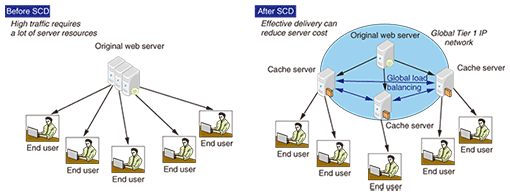
Fig. 2. Concept of SCD.
NTT Europe Online also provides a CDN platform called the Smart Content Delivery (SCD) service for web contents delivery, which is a global product managed through collaboration by NTT Communications, NTT America, and NTT Europe Online. SCD consists of two major components: cache servers and global load balancing. When contents are requested, the cache servers cache frequently accessed contents and provide the cached contents to the end users without accessing the original web server. Thus, they can reduce the load on the original web server, which can reduce the customer’s web server preparation costs and accelerate content delivery to end users, which improves their experience. The global load balancing has a function that assigns end users’ requests to the nearest cache servers, which can also improve the user experience, and achieves automatic fail over if the cache server goes down, which ensures outage-free service continuity. SCD currently has 12 points of presence (POPs) for cache servers in the world and covers Asia, the USA, and Europe. In Europe, the POPs are Amsterdam, Frankfurt, London, Paris, and Madrid. All the cache servers are connected to the global Tier 1 IP network, so high-speed connections are available for content delivery.
Recently, NTT Europe Online has also launched a CDN platform service for audio and video media streaming called the Smart Media Delivery (SMD) service in Europe. This service is provided in partnership with Flumotion, a Spanish company developing their own multiformat streaming platform. Flumotion’s streaming platform uses HTTP-based streaming and supports various formats including Flash, Silverlight, and Windows Media (Fig. 3). Since HTTP is suitable for firewalls and Flumotion’s platform works regardless of the end users’ operating systems, customers’ contents can be expected to be delivered in a usable format to almost 100% of end users. In addition, since Flumotion develops their own technologies, the SMD service can provide end-to-end solutions customised for customer’s demands unlike other service providers who use only Flash or Windows Media servers for content delivery. The SMD platform is distributed across the abovementioned five European POPs and provides contents to end users from the nearest POP. This also ensures service resiliency, so service can continue even if an outage occurs. This platform also provides functions for managing contents rights, blocking access from certain regions, and analysing regional access logs. Moreover, the SMD platform uses a scalable architecture so that its capacity can be increased easily in future.
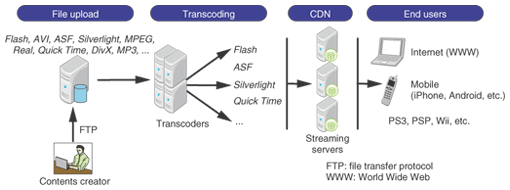
Fig. 3. Concept of SMD.
Many interesting contents such as sports events, movies, music, and services are created in Europe, and they are produced in various languages spoken throughout the world such as English, Spanish, and French. Many TV broadcasters are already providing their contents from their own websites in Europe. SCD and SMD can cover various aspects of content/service delivery, so they can help to make contents created in Europe available to the world.
4. Future perspective
NTT Europe and NTT Europe Online continue to make efforts to provide more sophisticated and integrated one-stop ICT solutions services for customers in EMEA. Such one-stop services let customers deploy their own services easily, so they can accelerate customers’ business in Europe and the rest of the world. For greater flexibility and more efficient operation, a private cloud platform will also be provided to customers. In addition, a CDN platform also helps to deliver customers’ contents to the world. The number of POPs will be increased to expand the coverage. For contents providers, one key to future growth of contents delivery via the Internet is to find ways of generating revenue. The SMD service will provide support for fee-based content services and ad-server-based monetisation for the contents provider in the future.
Reference
| [1] | NTT Europe Online. http://www.ntteuropeonline.com/ |
|---|
NTT Europe Online — short column
“Mind the gap.” You may hear this announcement if you take the Tube (London Underground) in London. Yes, I always mind the cultural gaps between the UK and Japan. Although there are many interesting ones, let me discuss the manner of drinking beer. This is very important for someone like me: I can order beer in several European languages, even though I usually don’t know other words and sentences. Una cerveza, por favor! Een pintje alstublieft!

Sign in London Tube

The Tube
You can find many traditional pubs in London, and they play an essential role in the lives of locals. Bitter is the speciality in the UK. It’s a bitter beer served cool but not cold, so some people do not like it, but I think it is eminently suitable for the wonderful English summer, which is bright with long daylight hours and not hot and muggy. I especially like drinking it outdoors in summer. Cold lager, which is the most familiar kind of beer in Japan, might be more suitable for the muggy hot summer in Japan, but it is also popular in the UK. Anyway, I sometimes drink beer with my colleagues after work to unwind. Perhaps that is a common event around the world.
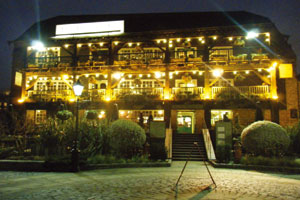
The Dickens Inn, St. Katharines Way, London
During my first month in London, I found it strange to drink beer in a pub. There are many people standing and chatting while drinking and they mainly drink without eating. Some pubs close the kitchen and do not provide meals in the evening. Snacks are available, but you can’t get them by table service: you have to go up to the bar yourself and ask for them. This is quite different from Japan, where you usually drink beer while sitting at a table and eating, though standing bars are becoming well-known in Japan. So, the Japanese drinking manner might be similar to that in a Spanish bar in Europe. But British people can drink beer for hours—three, four, even five or more—while standing and eating only snacks as they chatter. That was quite an interesting cultural difference for me.

Piccadilly Circus

Knightsbridge
Well, when in London, do as the Londoners do. During my first three months, I adapted and learned to drink beer in this manner. It has become a pleasure for me now. Although it is quite a useless skill, I finally managed to drink six pints of bitter without eating anything. Changing myself to drink a lot of beer in this manner showed me a different world กฤ. I must take care not to fall into the gap between the train and platform.








